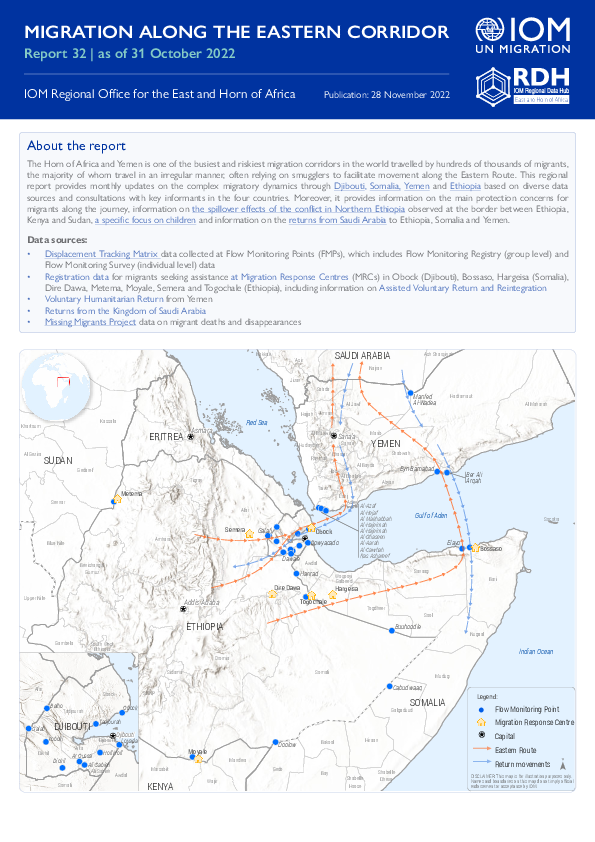-
Countries
-
Data and Analysis
-
Special Focus
-
Crisis Responses
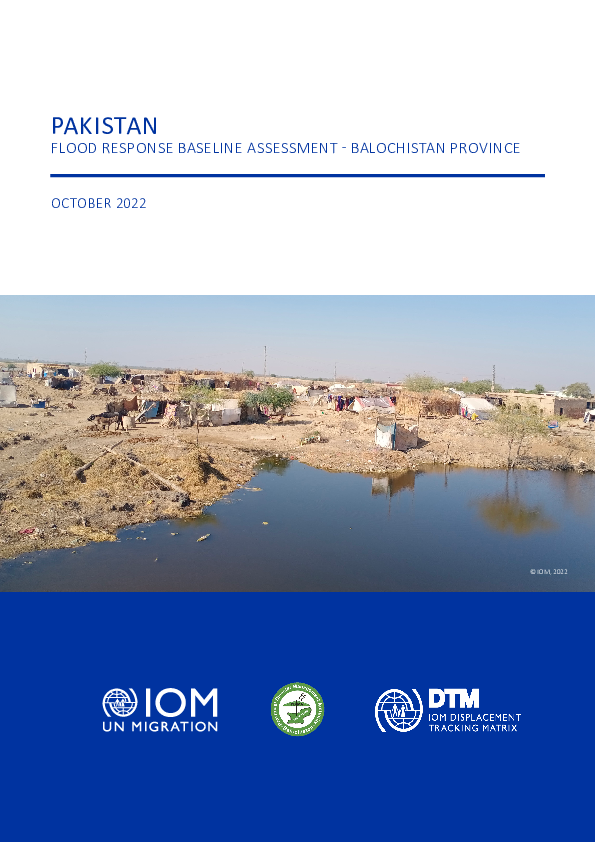
Contact
DTM Pakistan, iomisbdtmremapteam@iom.int
Language
English
Location
Pakistan
Period Covered
Oct 11 2022
Oct 17 2022
Activity
- Baseline Assessment
Storms and heavy monsoon rains in Pakistan have caused widespread flooding and landslides across the country. According to the National Disaster Management Authority (NDMA), up to 33 million people have been affected by the floods since mid-June 2022 and a total of 85 districts have been labelled by the Government of Pakistan as ‘calamity-hit’, as of 23 October 2022.¹ According to the NDMA Daily Situation Report No.132, 32 districts in Balochistan province are calamity-hit and an estimated total of 9,182,616 people are affected by the floods.² Besides that, 242 thousand houses are reported to be damaged in Balochistan province alone. However, the number of temporarily displaced persons (TDPs) were yet to be confirmed.
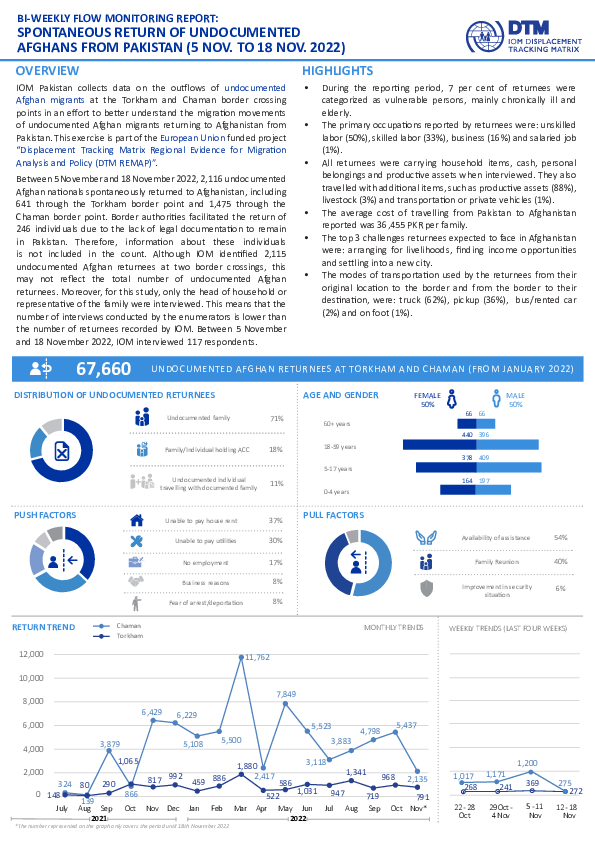
Contact
DTM Pakistan, iomisbdtmremapteam@iom.int
Language
English
Location
Pakistan
Period Covered
Nov 05 2022
Nov 18 2022
Activity
- Flow Monitoring
IOM Pakistan collects data on the outflows of undocumented Afghan migrants at the Torkham and Chaman border crossing points in an effort to better understand the migration movements of undocumented Afghan migrants returning to Afghanistan from Pakistan. This exercise is part of the European Union funded project “Displacement Tracking Matrix Regional Evidence for Migration Analysis and Policy (DTM REMAP)”.
Between 5 November and 18 November 2022, 2,115 undocumented Afghan nationals spontaneously returned to Afghanistan, including 640 through the Torkham border point and 1,475 through the Chaman border point. Border authorities facilitated the return of 246 individuals due to the lack of legal documentation to remain in Pakistan. Therefore, information about these individuals is not included in the count. Although IOM identified 2,115 undocumented Afghan returnees at two border crossings, this may not reflect the total number of undocumented Afghan returnees. Moreover, for this study, only the head of household or representative of the family were interviewed. This means that the number of interviews conducted by the enumerators is lower than the number of returnees recorded by IOM. Between 5 November and 18 November 2022, IOM interviewed 117 respondents.
Contact
DTM Yemen, iomyemendtm@iom.int
Location
Yemen
Activity
- Mobility Tracking
- Event Tracking
Period Covered
Nov 20 2022 -Nov 26 2022
From 1 January to 26 November 2022, IOM Yemen DTM tracked 9,568 households (HH) (57,408 Individuals) who experienced displacement at least once.
Between 20 and 26 November 2022, IOM Yemen DTM tracked 50 households (300 individuals) displaced at least once. The majority of people moved into/within the following governorates and districts:
- Marib (30 HHs) – Marib City (21 HHs), Marib (6 HHs), Harib (3 HHs) districts. Most displacements in the governorate originated from Marib and Sanaa.
- Al Hodeidah (10 HHs) – Hays (10 HHs) district. Most displacements in the governorate originated from Taiz.
- Ad Dali (9 HHs) – Qatabah (5 HHs), Ad Dali (4 HHs) districts. Most displacements in the governorate originated from Al Hodeidah and Ad Dali.
- Taiz (16 HHs) – Maqbanah (9 HHs), Jabal Habashi (1 HH), Sharab As Salam (1 HH) districts.
- Al Hodeidah (8 HHs) – Bayt Al Faqih (3 HHs), Al Jarrahi (2 HHs), Jabal Ras (1 HH) districts.
- Marib (6 HHs) – Harib (3 HHs), Rahabah (1 HH), Al Jubah (1 HH) districts.
Population Groups
Survey Methodology
Unit of Analysis Or Observation
Type of Survey or Assessment
Keywords
Geographical Scope
Administrative boundaries with available data
The current dataset covers the following administrative boundaries
The Horn of Africa and Yemen is one of the busiest and riskiest migration corridors in the world travelled by hundreds of thousands of migrants, the majority of whom travel in an irregular manner, often relying on smugglers to facilitate movement along the Eastern Route. This regional report provides monthly updates on the complex migratory dynamics through Djibouti, Somalia, Yemen and Ethiopia based on diverse data sources and consultations with key informants in the four countries. Moreover, it provides information on the main protection concerns for migrants along the journey, information on the spill over effects of the conflict in Northern Ethiopia observed at the border between Ethiopia, Kenya and Sudan, a specific focus on children and information on the returns from Saudi Arabia to Ethiopia, Somalia and Yemen.

Contact
DTM Sudan; dtmsudan@iom.int
Language
English
Location
Sudan
Snapshot Date
Nov 15 2022
Activity
- Mobility Tracking
- Event Tracking
The DTM Emergency Event Tracking (EET) is deployed to track sudden displacement and population movements, provide more frequent updates on the scale of displacement, and quantify the affected population when needed. As a subcomponent of the new Mobility Tracking methodology in Sudan (Round Four), and activated on a need basis, EET utilises a broad network of key informants to capture best estimates of the affected population presence per location – a useful tool for humanitarian response planning and design.

Contact
DTMUkraine@iom.int
Language
Ukrainian
Location
Ukraine
Period Covered
Oct 17 2022
Oct 27 2022
Activity
- Survey
Після 24 лютого 2022 року повномасштабне російське вторгнення в Україну спричинило безпрецедентну гуманітарну кризу по всій країні, що характеризується, серед іншого, переміщенням значної частини українського населення. Ще у квітні 2022 року Міжнародна організація з міграції (МОМ) почала фіксувати значну кількість повернень.
Умови повернення значно варіюють, оскільки люди повертаються як до регіонів, які безпосередньо не постраждали від війни, але в яких спостерігається значний притік внутрішньо переміщених осіб (ВПО), так і до регіонів, які постраждали від конфлікту, зазнали суттєвих руйнувань та були нещодавно деокуповані. Через нестабільність поточної ситуації неможливо визначити, яка частка людей повертається остаточно, а яка тимчасово. Однак наявні дані свідчать про те, що українці, які повертаються, мають особливий набір потреб і вразливостей, що відрізняє їх від тих, хто нікуди не переміщувався, і від ВПО.
Щоб підтримати партнерів у наданні цільової і доцільної допомоги особам, які повертаються до місць свого звичного проживання після вимушеного переміщення, МОМ презентує цей Звіт про повернення в Україні. Публікація має на меті проаналізувати останні дані МОМ щодо ситуації та потреб осіб, які повернулися, та щодо умов повернення, зібрані в ході оцінювань за Матрицею відстеження переміщень (МВП), проведених по всій країні.
Цей Звіт про повернення в Україні за жовтень 2022 року містить детальний аналіз даних, зібраних у ході десятого раунду Опитування загального населення (ОЗН), яке було проведено МОМ у період із 17 по 27 жовтня серед дорослого населення України. Географічне охоплення цього оцінювання покриває всю територію України, усі п’ять макрорегіонів (захід, схід, північ, центр, південь та місто Київ), за винятком Кримського півострова і не підконтрольних українському уряду територій. Опитування загального населення було проведено шляхом набору випадкових телефонних номерів, завдяки чому було анонімно опитано 2 002 унікальні респонденти віком від 18 років із використанням методу автоматизованого телефонного опитування (CATI).
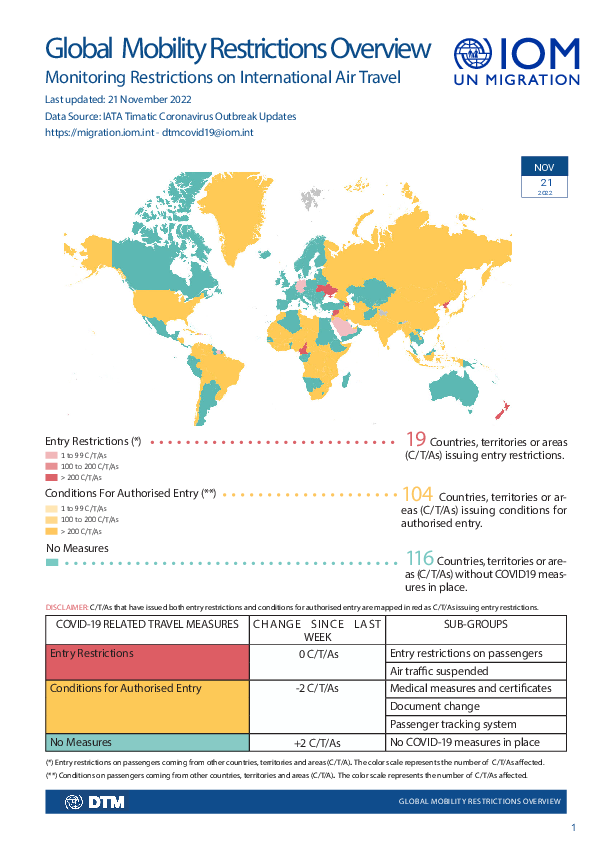
Contact
DTMcovid19@iom.int
Language
English
Location
Global
Period Covered
Nov 14 2022
Nov 21 2022
Activity
- Other
The DTM Global Mobility Restrictions Overview provides updates on international air travel restrictions and conditions for authorized entry. This overview aims to understand how COVID-19 has impacted human mobility, detailing how global and regional trends in air travel measures have evolved since COVID-19 was declared a global pandemic in March 2020. The data presented focuses on the changes in public health-related immigration and border management measures. It provides information intended to support IOM missions and partners in targeted response planning and advocacy for vulnerable populations who may be affected by changes in global mobility.
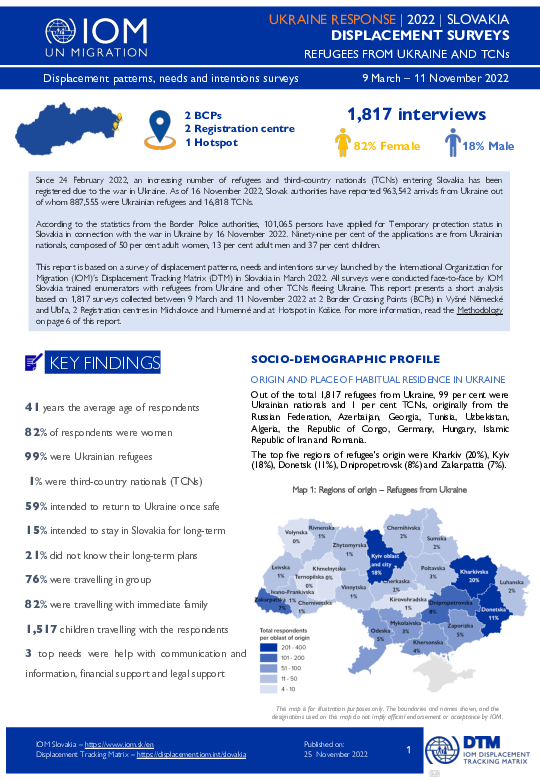
Contact
DTM Europe, DTMMediterranean@iom.int
Language
English
Location
Slovakia
Period Covered
Mar 09 2022
Nov 11 2022
Activity
- Survey
Since 24 February 2022, an increasing number of refugees and third-country nationals (TCNs) entering Slovakia has been registered due to the war in Ukraine. As of 16 November 2022, Slovak authorities have reported 963,542 arrivals from Ukraine out of whom 887,555 were Ukrainian refugees and 16,818 TCNs.
According to the statistics from the Border Police authorities, 101,065 persons have applied for Temporary protection status in Slovakia in connection with the war in Ukraine by 16 November 2022. Ninety-nine per cent of the applications are from Ukrainian nationals, composed of 50 per cent adult women, 13 per cent adult men and 37 per cent children.
This report is based on a survey of displacement patterns, needs and intentions survey launched by the International Organization for Migration (IOM)’sDisplacement Tracking Matrix (DTM) in Slovakia in March 2022. All surveys were conducted face-to-face by IOM Slovakia trained enumerators with refugees from Ukraine and other TCNs fleeing Ukraine. This report presents a short analysis based on 1,817 surveys collected between 9 March and 11 November 2022 at 2 Border Crossing Points (BCPs) in Vyšné Německé and Ubl'a, 2 Registration centres in Michalovce and Humenné and at Hotspot in Košice. For more information, read the Methodology on page 6 of this report.
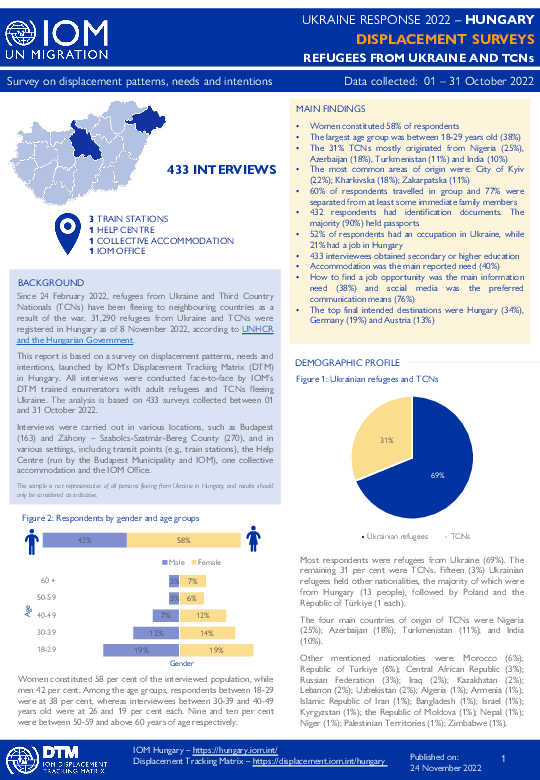
Contact
DTM Europe, DTMMediterranean@iom.int
Language
English
Location
Hungary
Period Covered
Oct 01 2022
Oct 31 2022
Activity
- Survey
- Flow Monitoring
Since 24 February 2022, refugees from Ukraine and Third Country Nationals (TCNs) have been fleeing to neighbouring countries as a result of the war. 31,290 refugees from Ukraine and TCNs were registered in Hungary as of 8 November 2022, according to UNHCR and the Hungarian Government. This report is based on a survey on displacement patterns, needs and intentions, launched by IOM’s Displacement Tracking Matrix (DTM) in Hungary. All interviews were conducted face-to-face by IOM’s DTM trained enumerators with adult refugees and TCNs fleeing Ukraine. The analysis is based on 433 surveys collected between 01 and 31 October 2022. Interviews were carried out in various locations, such as Budapest (163) and Záhony – Szabolcs-Szatmár-Bereg County (270), and in various settings, including transit points (e.g., train stations), the Help Centre (run by the Budapest Municipality and IOM), one collective accommodation and the IOM Office.

Contact
Regional Office Dakar, RODakar-DataResearch@iom.int, DTMBurkinaFaso@iom.int
Language
French
Location
Burkina Faso
Period Covered
Oct 05 2022
Oct 31 2022
Activity
- Flow Monitoring
L’OIM, a travers l’outil de Suivi des flux de populations (Flow Monitoring) de la Matrice de suivi des déplacements (DTM), récolte des données à des points d’entrée, de sortie et de transit clés, afin de mieux comprendre les mouvements de populations à travers l’Afrique de l’Ouest et du Centre. Le suivi des flux de population est une activité qui permet de quantifier et de qualifier les flux et tendances de mobilités, les profils des migrants, et les expériences et routes migratoires. Au Burkina Faso, des points de suivi des flux de populations (FMP) ont été progressivement installés sur plusieurs lieux de transit importants à Dori/Seytenga en février 2018, à Kantchari en mars 2018, ainsi qu'à Faramana et Yendéré en avril 2018 pour faire le suivi des flux migratoires dans le pays.
Au Burkina Faso, le suivi des flux de population se fait au niveau des quatre FMP et vise à mettre en lumière les zones particulièrement sujettes aux migrations transfrontalières et intrarégionales.
Ce rapport présente les données recueillies aux FMP du Burkina Faso en octobre 2022.
